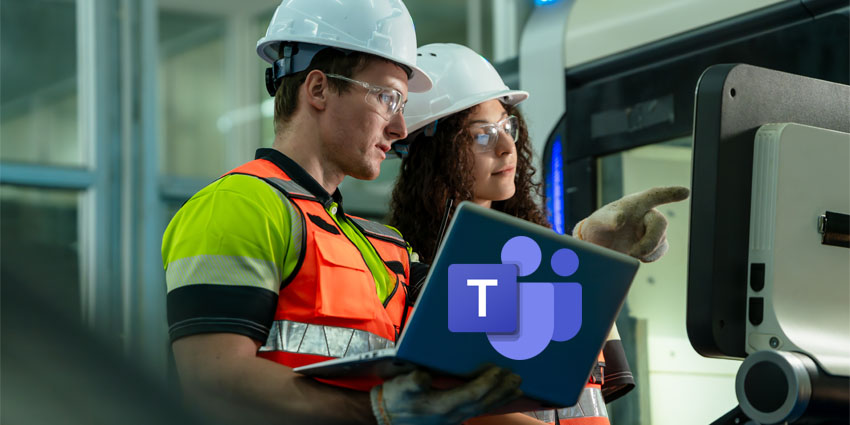Hybrid working has fundamentally altered how teams collaborate, communicate, and connect.
With a shift away from the traditional Monday-to-Friday office week and hot-desking becoming standard practice, employees may lack familiarity with available workspaces or meeting room technology. Thus, each new collaboration space represents a new territory.
“As the hybrid work environment becomes the new norm, I believe we can expect tremendous advancements in conferencing and collaboration technology,” Sam Sabet, Vice President & Chief Technology Officer at Shure explained.
“The transformation in this sector will be driven by the need for tools that facilitate seamless and intuitive communication.”
For instance, if a team books out a meeting space for its weekly team catch up but the only room available is one they haven’t used before, they may be unable to effectively navigate the technology to attend the meeting, resulting in exclusion of remote attendees, frustration, delays, or at worst, a cancelled meeting.
Equally, they might be able to work out how to join but might not be able to enable critical room devices like microphones to accurately capture everyone in the space.
This could result in the post-meeting transcripts and notes coming out as unclear or even missing some of the speakers entirely—meaning that the benefit of AI tools on platforms like Teams are lost.
When employees can focus on their work rather than struggling with complex meeting technology, productivity naturally follows.
Shure’s Human-Centric Approach to Collaboration
Shure has developed audio solutions for companies in the entertainment media space, all the way through to the conference and meeting room arena.
A century’s worth of experience in supporting continuously changing market and user demands has given the company an unmatched understanding of what users really want and need from technology.
“When we design a solution, it’s not enough to just concentrate on the technical capabilities, what we really want to understand is the human element,” Sabet explained.
“A human-centric approach is absolutely crucial. In the context of collaboration and conferencing, technology solutions should be created with the end-user in mind. This means considering comfort, accessibility, and ease of use.”
Such design thinking is ingrained throughout Shure’s product development process, which emphasizes user testing in real-world environments to ensure solutions match actual collaboration behaviors.
“It starts with an in-depth understanding of our users’ needs through extensive research, including surveys, interviews, and observational studies. We prioritize feedback loops throughout the product lifecycle, ensuring that every stage of development reflects user input and real-world application.”
“We design our products to be flexible, adaptable and easy to reconfigure based on the needs of the user,” he added.
This philosophy underscores a belief that technology should adapt to humans, not the other way around.
One example of this is Shure’s ceiling array microphones and intelligent DSP systems, which can capture clear audio from participants regardless of where they sit in a room and how loud or soft they talk, while simultaneously filtering out background noises that would otherwise disrupt understanding.
Not only does this reflect the importance of capturing everyone clearly so remote attendees can hear and engage equitably, but it also extends to the people in the room, and thus enabling everyone to participate fully, whether remote or in-person.
“One of our latest collaboration solutions, the IntelliMix Room Kit, stands as a testament to our commitment to enhancing the user experience through innovative design,” Sabet explained.
“It integrates our advanced audio capture technologies and sophisticated DSP algorithms to deliver crystal-clear quality. One of the key benefits is its ability to focus on talkers’ voices, automatically adjust audio levels and eliminate background noise, so that every participant can hear and be heard clearly.”
Shure’s solution for Microsoft Teams Rooms automatically optimizes audio performance without requiring technical expertise from users, allowing teams to focus on collaboration rather than configuration.
“What truly sets the IntelliMix Room Kit apart is its AI-driven features that recognize and adapt to the dynamic acoustic environment of a room to ensure clear vocal intelligibility,” noted Sabet.
“These sophisticated algorithms enhance speech and filter unwanted noise to improve transcription accuracy, significantly reducing the need for manual corrections and allowing users to fully engage in their meetings without distraction.”
Scalability and adaptability also feature prominently in Shure’s product ecosystem. This acknowledges the changing nature of the rooms in dynamic hybrid offices where these solutions may be deployed.
“As we look ahead, the key will be ensuring that our solutions not only meet current user demands but also anticipate the evolving needs of hybrid work environments.”
Shure’s networked systems can be implemented in environments ranging from small huddle rooms to large conference spaces. Modular and future-proof technology platforms also allow flexible reconfiguration as needs change, maintaining consistent performance and user experience across an organization’s entire collaboration infrastructure.
This scalability ensures that as businesses grow and their collaboration needs evolve, their technology investments remain relevant and effective. “Another significant advancement will be in the realm of interoperability,” Sabet said.
“Technologies that integrate a wide range of devices and platforms will become crucial. We’ll see increased compatibility among different video conferencing systems, allowing users from different organizations and setups to connect seamlessly.”
But what all these elements combined really represent is productivity gains. When meetings start promptly without technical delays, when participants can hear clearly without straining, and when your systems can effectively collect data for things like AI, the efficiency of collaborative sessions increases dramatically.
The Future of Successful Hybrid Work is Human-Centric
As hybrid work continues to define the modern workplace landscape, the importance of human-centric design cannot be overstated.
“In essence, the future of conferencing and collaboration technology in modern work settings will hinge on ease of use, intelligent interactivity, and dynamic adaptability to enhance productivity and human connection beyond geographical boundaries,” Sabet said.
Organizations that prioritize human needs and experiences in their infrastructure investments will gain significant advantages in employee satisfaction and productivity.
“Technology is merely a tool to facilitate human interaction,” Sabet emphasized.
“We need to focus on how users interact with and benefit from these tools rather than just forcing the newest capabilities,” he added.
When technology reduces friction rather than creating it, it facilitates communication and gives space for new ideas to be created.
“The goal is to connect people, not just through higher degrees of technological integration but also through a deeper understanding of the human elements that make effective communication possible.”
By developing solutions that enhance rather than complicate human communication, Shure enables organizations to turn technology from an annoyance into an asset.







